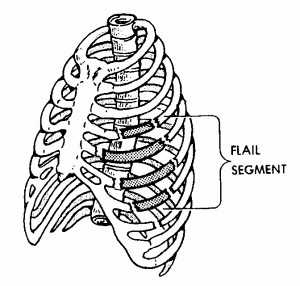A flail chest results when three or more ribs are broken in two or more places, allowing rib segments to “float” (figure 3-10).
The sternum may also be fractured.
Floating rib segments may damage a lung, major blood vessels, or the heart. Lung tissue lying under the flail segment is usually damaged, resulting in internal bleeding and swelling which interferes with respiratory function.
a. The floating rib segments do not follow the normal chest movements. Their movement is paradoxical (opposite normal) in that the floating rib segments move in when the casualty inhales and out when the casualty exhales.
b. Other indications of a flail chest include a lack of lung expansion resulting in loss of effective lung volume. The casualty usually tries to breathe deeply to offset the decrease in lung efficiency. Severe hypoxia and cyanosis can occur quickly in spite of the casualty’s efforts.

